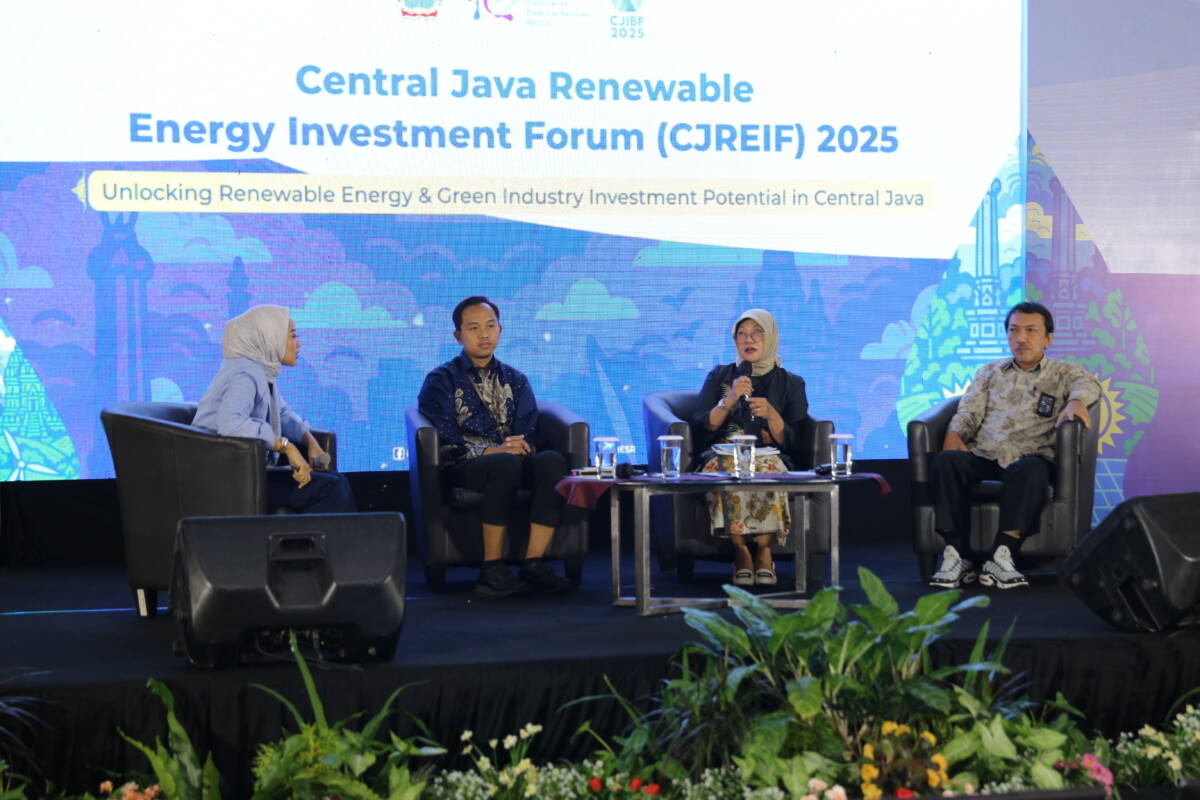Semarang, June 26, 2025 – Central Java is solidifying its position as a pioneer in Indonesia’s energy transition. With abundant renewable energy potential and a strong commitment from various stakeholders, the province is determined to become a center for clean energy development and green industry, while significantly contributing to the national Net Zero Emission (NZE) target.
Pintoko Aji, Coordinator of Data Research and Modeling at the Institute for Essential Services Reform (IESR), stated that the technical potential for renewable energy in Central Java is estimated at approximately 197.96 GWp. According to IESR’s 2021 study entitled “Beyond 443 GW”, the technical potential for the development of Solar Power Plants (PLTS) in Central Java reaches 194.28 GWp, Wind Power Plants (PLTB) 2950.3 MWp, and the potential for Micro-hydro Power Plants (PLTM) utilization reaches 730.3 MWp. This study was further refined by analyzing potential locations for renewable energy development, including financial feasibility, considering various factors outlined in a study titled “Unlocking Indonesia’s Renewables Future: the Economic Case of 333 GW of Solar, Wind and Hydro Projects” (2025). Both studies then became the basis for mapping renewable energy potential specifically for Central Java Province.
“Twelve locations in several areas within Wonogiri Regency, Boyolali Regency, Cilacap Regency, Brebes Regency, Rembang Regency, Semarang Regency, Kudus Regency, Wonosobo Regency, and Banjarnegara Regency have been studied for PLTS potential; two locations for PLTB (in Wonogiri and Pemalang); and two locations for PLTM in Cilacap Regency. Meanwhile, PLTS has a wider distribution, covering almost all regencies. This technical study has been converted into economic and financial terms to facilitate understanding for investors and local governments,” said Pintoko.
Furthermore, Pintoko highlighted the latest policy in PLN’s Electricity Supply Business Plan (RUPTL), which emphasizes that Central Java will no longer build fossil-based power plants. All additional electricity capacity will come from renewable energy sources. This condition, according to Pintoko, opens up significant opportunities for the development of green industries because the industrial sector requires a clean and stable electricity supply.
“To simplify things for investors, IESR has compiled a systematic catalog of renewable energy potential data, covering locations that are ready for development and are already bankable. Therefore, all parties need to seize this opportunity as a form of collaboration in realizing the energy transition,” Pintoko stressed at the Central Java Renewable Energy Investment Forum (CJREIF) 2025 on Thursday (June 26).
Sakina Rosellasari, Head of the Investment and One-Stop Integrated Services Department (DPMPTSP) of Central Java Province, affirmed that in the preparation of the Regional Investment Plan (RUPM), green industry is one of the six main priorities. Her department is determined to make the use of new and renewable energy mandatory to support industrial activities, in line with the grand vision of the Regional Medium-Term Development Plan (RPJMD) 2025–2029.
“We aim for economic growth of 8% to be achieved with 12% investment, a large part of which is directed towards the environmentally friendly sector,” added Sakina.
Natasha Gabriella, Head of Sustainability, Communications, and Public Affairs at Coca-Cola Euro Pacific Partners Indonesia (CCEP), explained that approximately 30% of the electricity used for their operations came from renewable energy sources in 2024. They have also installed Rooftop Solar Power Plant (PLTS) systems at three locations with a total investment of more than IDR 100 billion. Additionally, they have committed to purchasing 90 GWh of Renewable Energy Certificates (RECs) from Perusahaan Listrik Negara (PLN), representing an investment of approximately IDR 5 billion.
“While on-site renewable energy is crucial, to achieve our net-zero target, access to large-scale off-site renewable energy sources is needed. We look forward to collaborating with PLN for the development of broader offerings, such as green tariffs and green energy-as-a-service, as well as regulations that allow companies like CCEP to adopt mechanisms such as Corporate Power Purchase Agreements (corporate PPAs) and shared use of transmission and distribution networks. These mechanisms will provide the scale and diversity needed to meet our 100% renewable energy utilization (RE100) commitment, while also supporting Indonesia’s renewable energy targets,” said Natasha.
Zainal Arifin, Executive Vice President of Various New and Renewable Energy at PT Perusahaan Listrik Negara (PLN), stated that Central Java has a combination of renewable energy sources capable of reliably supporting the system’s needs, such as Hydroelectric Power Plants (PLTA) and geothermal. With these energy sources, PLN no longer needs fossil power plants to balance fluctuations from intermittent PLTS and biomass.
“Furthermore, Central Java’s geographical position in the middle of Java Island allows the province’s electricity system to help support the electricity needs of neighboring provinces. With vast potential, strong policy support, and commitment from various parties, Central Java is ready to become a model for energy transition and green industry development in Indonesia,” said Zainal.

